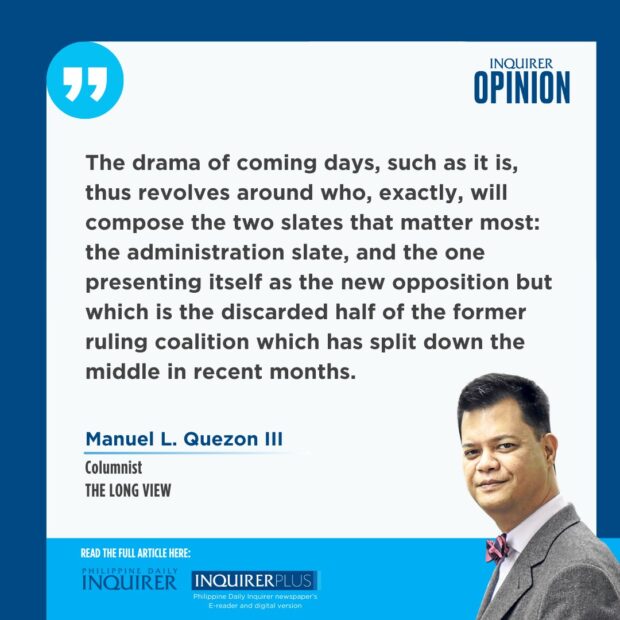
In three days, the period for parties to hold their conventions will run out. The filing of candidacies, including substitutions, will come next, from Oct. 1-8. Then the hiatus before the campaign season formally begins in February. People poring over the various surveys have probably reached three inescapable conclusions. The first is that celebrity and money (including past incumbency in the Senate) confer a tremendous advantage. The second is that this leaves little room for newcomers when proven vote-getters decide to return to the Senate. The third is that the national threshold to win is high indeed: a minimum of 30 percent of the vote, or 20-21 million votes, to have a serious chance. Which are precisely the odds the campaign contributors and coalition builders have been weighing, with the surveys as their weighing scales.
What will be at stake in the 2025 midterm elections is the Marcos Restoration administration: will it win what every midterm is for a sitting president—a referendum on the incumbent’s leadership and performance? At stake is 2028 and whether the administration goes into the second half of its term, empowered or a lame duck.
For everyone else, the goal is to convince the electorate that the administration should be denied a vote of confidence by shrinking, if not outright defeating, the administration’s Senate slate. As the top-ranking official in the discarded half of the former ruling coalition, the Vice President has to decide whether she will keep the President firmly in her sights, or whether she will give in to her even greater animosity for the Speaker of the House—who, however, has little skin in the game, so to speak. No administration has ever lost the House of Representatives, no president has not hand-picked the speaker, there is no reason to think things will be different come 2025. Even the party the Speaker heads, Lakas-CMD, only produced one contribution to the administration’s Senate slate: Ramon Revilla Jr. (and one conspicuous absence when it was announced: Gloria Macapagal Arroyo).
Related to this is the traditional expectation that whoever is the Senate topnotcher in any midterm, is automatically a leading contender for the presidency in the coming presidential contest.
The Makabayan coalition or the radical Left announced a 10-person slate on National Heroes Day, composed of former legislators and high-ranking members of its various component organizations, less as an actually competitive slate and more to wedge itself firmly into the national conversation, a luxury it can afford because it has turned maximizing its party list representation into a science. For those composing the Center-Left, the Liberals and Akbayan have decided to pursue a different strategy.
Though the Liberals who are still fielding Kiko Pangilinan for the Senate but who have decided—wisely—to contest the party list vote, with the prospect of putting Leila de Lima, Teddy Baguilat, and Lorenzo Tañada III in the House, a strategy that will also be pursued by Akbayan which, if it wins back party list representation, can send Chel Diokno to the House as its nominee.
Leni Robredo’s back-to-basics move has resulted in former foes turned friendly faces—because she is now a local baroness and no longer aspiring to national office—making a beeline for Naga City. It’s also a reminder of how underestimated the 2022 Center-Left coalition’s size was: if Mrs. Arroyo hadn’t brokered the alliance that won in 2022, that election would likely have turned out to be a typical Fifth Republic multiparty contest where victory would go to a candidate who eked out a larger minority than all the others.
Instead, a majority was achieved for the first time in the Fifth Republic (and also since the Third Republic) and this, in the end, was the foundation that held firm for the President and which ultimately deprived his predecessor of a firm political foundation. Because the former president never bought into the grand dreams of Leoncio Evasco Jr. to establish a national movement to supplant the existing mercenary political parties, now that he needs it, his own party has shrunk and his allies are on the run. Now that the up-to-recently-ruling-coalition split, we are closer to the configuration going into the 2022 Marcos-Duterte coalition negotiations.
The drama of coming days, such as it is, thus revolves around who, exactly, will compose the two slates that matter most: the administration slate, and the one presenting itself as the new opposition but which is the discarded half of the former ruling coalition which has split down the middle in recent months. In 2019, Rodrigo Duterte achieved the best midterm results since the prewar Commonwealth; will that pandemic election remain a record, and the 2025 results less extreme? Will it be measured by the Fifth or Third Republic midterms? Because it is widely expected to be Round 1 of the 2028 showdown.
—————-
Email: mlquezon3@gmail.com; Twitter: @mlq3